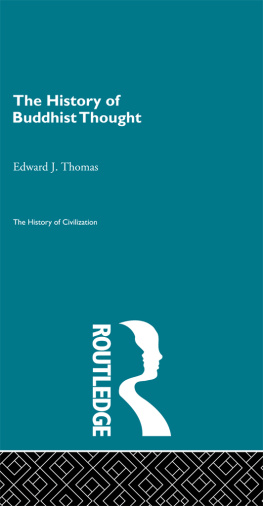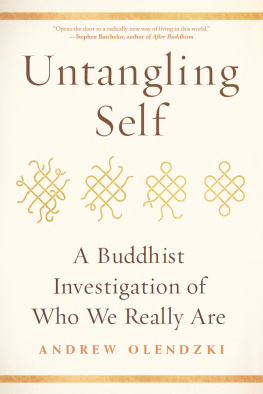THE HISTORY OF CIVILIZATION
THE HISTORY OF BUDDHIST THOUGHT
THE HISTORY OF CIVILIZATION
General Editor C. K. Ogden
The History of Civilization is a landmark in early twentieth Century publishing. The aim of the general editor, C. K. Ogden, was to summarise in one comprehensive synthesis the most recent findings and theories of historians, anthropologists, archaeologists, sociologists and all conscientious students of civilization. The History, which includes titles in the French series LEvolution de lHumanit, was published at a formative time in the development of the social sciences, and during a period of significant historical discoveries.
A list of the titles in the series can be found at the end of this book.
A BODHISATTVA : GANDHRA SCHOOL
First published in 1933 by Routledge
Reprinted in 1996,1998 by Routledge
2 Park Square, Milton Park,
Abingdon, Oxon, 0X14 4RN
&
270 Madison Ave,
New York NY 10016
Transferred to Digital Printing 2008
1996 Routledge
All rights reserved. No part of this book may be reprinted or utilized in any form or by any means electronic, mechanical, or other means, now known or hereafter invented, including photocopying and recording, in any information storage or retrieval system, without permission in writing from the publishers.
British Cataloguing in Publication Data
ISBN: 0-415-15592-4
ISBN Eastern Civilization (10 volume set): 0-415-15614-9
ISBN History of Civilization (50 volume set): 0-415-14380-2
ISBN 978-1-136-20044-1 (ePub)
Publishers Note
The publisher has gone to great lengths to ensure the quality of this reprint but points out that some imperfections in the original may be apparent
| PLATE. |
| I. | A BODHISATTVA : GANDHRA SCHOOL |
| II. | THE WHEEL OF BECOMING |
| III. | GOTAMA PRACTISING AUSTERITIES |
| IV. | Above : BUDDHAS FIRST SERMON |
| Below : PRESENTATION OF O MAIPADME H |
Pl. I. Bodhisattva of the Gandhra school. The figure, 5 ft. 9 in. high, probably from Yusufzai near Peshawar, is in the possession of Messrs. E. Goldston, 25 Museum Street, London, to whose kindness I am indebted for the reproduction. The sculptures of the Gandhra school are found on the North-West Frontier, and belong to the Kushna period from the first century B.C. to the fourth century A.D., but we have no means of exactly dating any of the figures. They were evidently produced by workmen with a knowledge of Greek sculpture, but the ideas that they reveal are purely Indian.
Pl. II. The Wheel of Becoming, from Journ. As. Soc. Bengal, 1898, vol. lxi, pt. 1, p. 133 ; described below, p. 69.
Pl. III. Gotama practising austerities before he found the true method of meditation. Gandhra figure found at Sikri in the Peshawar District by Captain Deane in 1889, now in the Lahore Museum ; see JA., 1890, i, p. 139.
The prominence on the head is one of a Buddhas thirty-two bodily marks, which appear also on bodhisattvas in their last birth (below, p. 142). One of these is that he is said to be ushsha-rsha or uhsa-ssa, turban-headed, a term which as applied to a bodily mark can only mean having the head in the shape of a turban. This is how it was interpreted by the later Indian artists, who represented a prominence of the skull covered with short curls, and it has been assumed that they were trying to copy the bunched-up hair of the Gandhra figures. But this mark is mentioned in the list of marks as given by all known schools, and these lists must have been already in existence when the Gandhra art arose. There is no reason to think that these artists were ignorant of the tradition, and the probability is that the bunched-up hair of the Gandhra figures is their way of indicating the mark without making it appear as a deformity.
Pl. IV. The two scenes are from paintings in a MS. of the Krada-vyha from Nepal in the possession of H. Wilkinson, Esq., C.S.I., C.I.E, who has kindly lent the MS. for reproduction. In the first the preaching of the First Sermon to the five disciples in the deer park at Benares (see p. 140) shows how Mahyna continued to preserve the old legend and recognize the Hnayna teaching. In the second the bodhisattva Sarvanvaraavishkambhin is receiving the spell, Om manipadme h, from a reciter of the Doctrine as described in the Kraa-vyha (below, p. 192), and Avalokitevara in the sky is giving his approval.
On Gandhra art see A. Foucher, The Beginnings of Buddhist Art (1917). On the significance of art and religion M. Focillons Lart bouddhique, Paris, 1921, is a work of deep penetration and sympathy.
A HISTORY of Buddhism in the sense of a connected account of the chief events of all the Buddhist communities throughout the centuries is an ideal not yet attainable. The monumental Cambridge History of India is blazing a path, but it has so far completed only the first volume of the Hindu portion. Merely to record the known facts of some two thousand years of Buddhism would require more than one volume.
During the last few years several important works dealing with the less explored regions of Buddhism have appeared. Dr. N. Dutts Aspects of Mahyna Buddhism is more fundamental than appears from the title, and in The Bodhisattva Doctrine in Buddhist Sanskrit Literature Dr. H. Dayal has devoted much intensive research to one special development. A general treatment has been begun by Dr. McGovern in his Manual of Buddhist Philosophy, vol. 1, and in An Introduction to Mahyna Buddhism. From Dr. B. M. Barua we have Prolegomena to a History of Buddhistic Philosophy.
The earliest period has also received new attention. This period, according to Mrs. Rhys Davids, was so different from the picture that we find in our earliest records that she prefers to call it not Buddhism but Sakya. Put away, for your origins, the word Buddhism and think of your subject as Sakya This is really a religious question, and the interest that Buddhism still rouses from this point of view can be seen from Bishop Gores Gifford Lectures, The Philosophy of the Good Life, and the Bampton Lectures of Canon Streeter, The Buddha and the Christ. It is Buddhism as we find it actually recorded, not a hypothetical primitive system, which still forms a challenge to other religions.
Through the labours of Rhys Davids and his colleagues it has become possible to form a clear idea of one of the earliest schools of Buddhism, that of the Pli tradition still flourishing in Ceylon, Burma, Siam, and Further India. It was no fault of these investigators if they were satisfied that here we have the earliest known form, or even the primitive form, of Buddhism and that all that followed was degeneration. For Mrs. Rhys Davids even the earliest known form was degeneration. But other scholars have been at work, and we now know of other schools with an equal right to claim that they were holding the primitive teaching. The problem about the primitive teaching now becomes actual.
The problem of the later history of Buddhism has also become actual. Philosophically it was no degeneration, but a great advance. This has been brought out by Professor A. B. Keith in his











